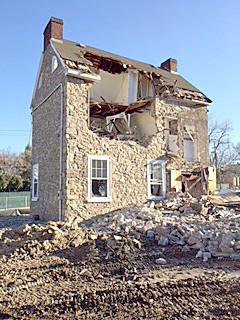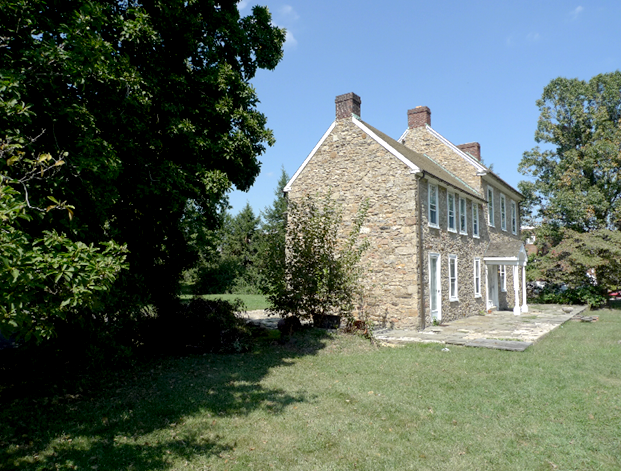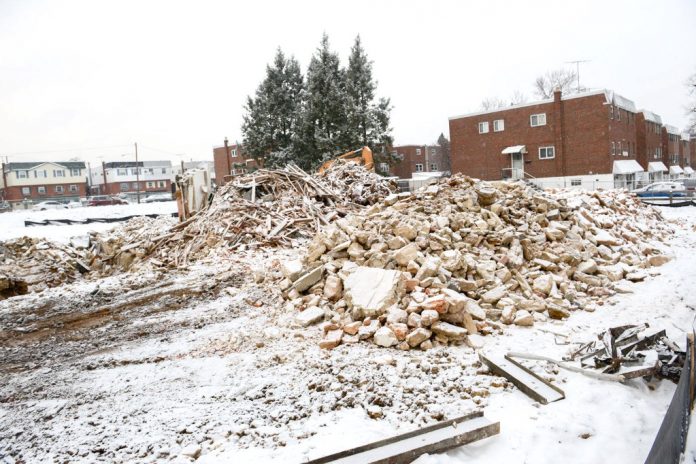Going, going, gone: Demolition of the old Stokes House began on Jan. 5 and lasted for three days. Historians were allowed to salvage a 19th-century Castor stove that they donated to the Castor collection of the Historical Society of Frankford. Others kept some building stones. Deeds for the property date as far back as 1747. PHOTOS COURTESY OF Elsie Stevens / MARIA POUCHNIKOVA
How much is a slice of Northeast Philadelphia’s history worth?
In September 2011, the centuries-old Stokes House on Welsh Road near Axe Factory Road was worth $200,000. That’s what a couple of real estate developers paid Samuel C. “Buzz” Stokes Jr. for the place after Stokes had pleaded guilty to criminal charges stemming from the state’s Bonusgate political corruption scandal.
Last October, the Federal-style stone farmhouse and one acre of surrounding land jumped in value to $540,000 as a builder, Toner Homes Inc., bought the property from business partners John Parsons and Charles Calvanese.
Now, Toner is erecting a dozen twin houses on the site that will be expected to sell for about $290,000 apiece once complete. Demolition of the old Stokes House began on Jan. 5 and lasted for three days.
“We were devastated … but we knew it was coming. Our fight was over,” said Elsie Stevens, a neighborhood activist and former president of the Holme Circle Civic Association. “I felt bad that it happened on our watch and that it came down after 200 years. We were resigned to the fact that we couldn’t do anything more [to save it], but we tried.”
“It’s just another example of our inability to save the past. And there are very few locations in the Northeast, particularly the Far Northeast, that go back that far,” said local historian Fred Moore.
The old home, at 2976 Welsh Road, got its familiar name from the family that lived there for most of the 20th century. Samuel C. Stokes Sr. bought it in 1943 when the surrounding community looked much different than it does today.
At the time, expansive open spaces largely characterized Northeast Philadelphia north of Cottman Avenue. There were farms and large undeveloped tracts. Villages like Holmesburg, Fox Chase, Bustleton, Somerton and Mechanicsville dotted the map. Large-scale development didn’t begin in earnest until after World War II, when builders scooped up most available space to profit on the Baby Boom and urban flight.
According to a history of the property circulated by The Millbrook Society, deeds for what became known as the Stokes House date as far back as 1747. Before then, the site was part of the plantation estate of Thomas Holme, William Penn’s surveyor general. When Holme died in 1695, he emancipated his slaves, whose families acquired land and developed a community in the area. Their descendents worshiped at Bethany AME Church, which still stands on Ashton Road nearby.
By the early 1800s, a log cabin and stone barn occupied the Stokes property. A Revolutionary War veteran may have lived there. Later, a U.S. Army colonel and Civil War veteran owned it briefly. The deed history also includes several wealthy businessmen and landowners.
The main portion of the recently demolished stone house was built in the middle-to-late 1800s. When the elder Stokes bought it, the building was being used for an animal shelter and feed storage. Stokes rehabbed the place and built an addition with stones from the old barn. Stokes Sr. sold off much of the land to home builders after World War II while retaining about one acre. Eventually, Stokes Jr. took over the house and rehabbed it again in the 1990s. Stokes’ criminal charges arose as a result of his work for his brother-in-law, former state House Speaker John Perzel, who also was convicted and jailed in Bonusgate.
Owners never sought historical designation for the house. Around the time when Stokes Jr. began marketing the property in 2010, he told the Holme Circle Civic Association that the home was again in disrepair and that restoration would not be cost-effective. Parsons reiterated that view in early 2012 after he and Calvanese had bought the site.
Moore, the Northeast historian, thinks that those perspectives overlook the site’s historical value.
“If we want to save our history so that we can see it — not just hear about it or read about it or see videos of it — we have to save houses like this,” Moore said. “We want to be able to go there and touch the stones. We don’t want to experience things through virtual reality.”
The home was representative of a time and place that might easily be lost on future generations without examples to be seen.
“That was the value of it,” Moore said.
The largely urban Northeast was very much a rural place as recently as 70 years ago. In Holmesburg, there are a couple of 19th-century townhouses, according to Moore, while one old stone farmhouse remains near Willits and Ashton roads.
“One of the disadvantages (of the Stokes House) was no one famous lived there. Nothing famous happened there. But it was on a major road, Welsh Road, for 200 years,” Moore said.
Stevens and others were granted a final tour of the house months ago when it became clear that demolition would occur. They were allowed to salvage an old Castor stove that they donated to the Castor collection of the Historical Society of Frankford. Stevens also kept some building stones.
“The Stokes family lived there since the 1940s. They loved it, too, and the community shared a love for the house with them,” Stevens said. ••

Going, going, gone: Demolition of the old Stokes House began on Jan. 5 and lasted for three days. Historians were allowed to salvage a 19th-century Castor stove that they donated to the Castor collection of the Historical Society of Frankford. Others kept some building stones. Deeds for the property date as far back as 1747. PHOTOS COURTESY OF Elsie Stevens / MARIA POUCHNIKOVA

Going, going, gone: Demolition of the old Stokes House began on Jan. 5 and lasted for three days. Historians were allowed to salvage a 19th-century Castor stove that they donated to the Castor collection of the Historical Society of Frankford. Others kept some building stones. Deeds for the property date as far back as 1747. PHOTOS COURTESY OF Elsie Stevens / MARIA POUCHNIKOVA

Going, going, gone: Demolition of the old Stokes House began on Jan. 5 and lasted for three days. Historians were allowed to salvage a 19th-century Castor stove that they donated to the Castor collection of the Historical Society of Frankford. Others kept some building stones. Deeds for the property date as far back as 1747. PHOTOS COURTESY OF Elsie Stevens / MARIA POUCHNIKOVA





